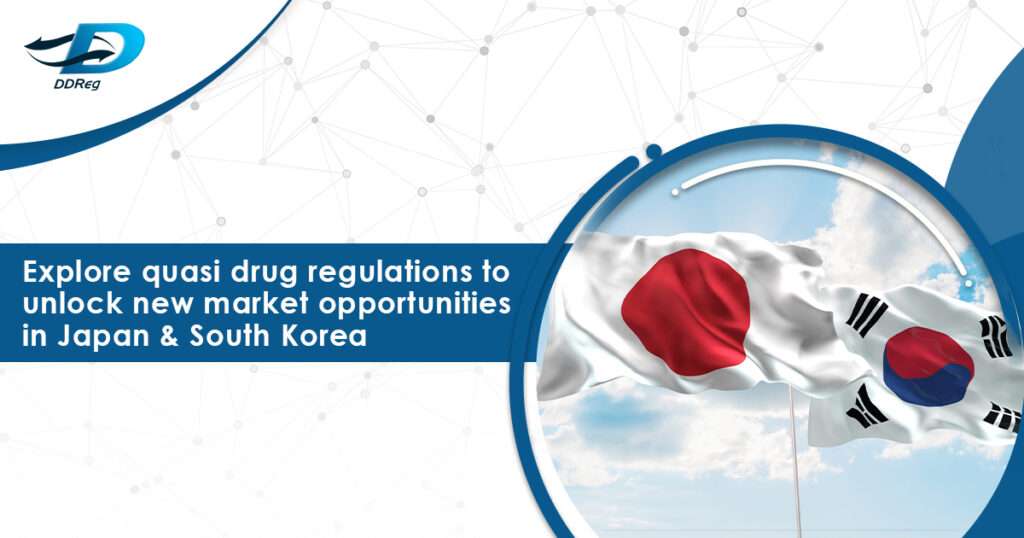
In the dynamic Asia-Pacific market, quasi drugs represent a unique regulatory category that bridges the gap between cosmetics and pharmaceuticals. Particularly in Japan and South Korea, quasi drugs have gained traction for their hybrid benefits offering therapeutic claims while maintaining a relatively simpler regulatory pathway compared to full-fledged drugs.
Understanding the regulatory and commercial landscape of quasi drugs in these two key markets is essential for global companies aiming to enter or expand in East Asia. This article explores the updated guidelines, approval requirements, and commercialization opportunities for quasi drugs in Japan and South Korea.
What Are Quasi Drugs?
Quasi drugs are defined as products that have mild pharmacological effects or physiological functions. They may not be as potent as traditional drugs, but they go beyond the scope of general cosmetics. These products can include:
- Medicated shampoos
- Hair growth tonics
- Anti-acne treatments
- Skin brightening products
- Mouthwashes
- Deodorants
Their positioning allows manufacturers to market therapeutic benefits while navigating a less complex regulatory environment than prescription or over the counter (OTC) drugs.
Japan: Mature Market, Stringent Classification
Regulatory Authority:
In Japan, quasi drugs are regulated by the Pharmaceuticals and Medical Devices Agency (PMDA) and the Ministry of Health, Labour and Welfare (MHLW) under the Pharmaceutical and Medical Device Act (PMD Act).
Classification & Approval:
Products are classified into cosmetics, quasi drugs, or pharmaceuticals. Quasi drugs must receive pre-market approval from MHLW. The process involves:
- Submission of a product dossier including ingredient safety, clinical and non-clinical data (if applicable), and label claims
- Approval of product formulas, packaging, and manufacturing facilities
- Good Quality Practice (GQP) and Good Vigilance Practice (GVP) compliance for manufacturers and importers
A list of approved active ingredients and permissible claims (known as the “Notification-based approval list”) is maintained and regularly updated by the MHLW. As of 2024, Japan has strengthened scrutiny on skin-lightening agents and anti-hair loss formulations due to safety concerns.
Timelines:
Approval timelines for these drugs in Japan can range from 6–12 months, depending on the complexity and whether the product is a novel formulation.
South Korea: Innovation-Driven with Evolving Definitions
Regulatory Authority:
In South Korea, quasi drugs fall under the purview of the Ministry of Food and Drug Safety (MFDS), governed by the Pharmaceutical Affairs Act.
Scope and Categories:
The MFDS classifies products into five main categories of quasi drugs, such as:
- Sanitary aids (e.g., sanitary pads)
- Disinfectants
- Anti-hair loss agents
- Oral hygiene products
- Some health-related cosmetics
Korea’s quasi drug list continues to evolve, especially with functional cosmetics overlapping in purpose. Regulatory updates in 2023 and 2024 have clarified distinctions between functional cosmetics and quasi drugs, particularly around ingredient functions, safety, and consumer risk profiles.
Registration Process:
Quasi drug registration in Korea involves:
- Pre-market approval or notification (depending on the product type)
- Product testing and data submission on efficacy, quality, and safety
- Factory or manufacturer registration and GMP compliance
Korea also places a strong emphasis on post-market surveillance, including adverse event reporting and recalls, even for low-risk quasi drugs.
Commercial Opportunities & Market Entry Considerations
These markets in both Japan and South Korea are attractive due to rising consumer demand for self-care and preventive health products. As of 2024:
- Japan’s quasi drug segment is valued at over USD 10 billion, driven by aging population needs and personal hygiene awareness.
- South Korea is experiencing a rise in cosmeceutical innovation, with quasi drugs positioned as “wellness” solutions that resonate with tech-savvy consumers.
However, companies must navigate:
- Complex regulatory pathways, especially for new ingredients or formulations
- Localization of labeling and claims, including Japanese and Korean language requirements
- Cultural preferences in product presentation and functionality
How DDReg Supports Your Quasi Drug Strategy
Successfully launching a quasi drug in Japan or South Korea requires regulatory precision, local insight, and strategic positioning. DDReg brings deep expertise in:
- Product classification and regulatory strategy
- Dossier preparation and submission to PMDA and MFDS
- GMP/GQP/GVP compliance support
- Label and claim reviews tailored to local requirements
- Post-market surveillance and renewals
Our localized approach helps reduce time-to-market while ensuring full compliance with regional requirements.
Conclusion
Quasi drugs offer a powerful entry point into the highly regulated yet commercially promising healthcare markets of Japan and South Korea. Companies willing to invest in robust regulatory planning and partner with experienced local advisors stand to benefit from this unique product category.
Looking to register or commercialize quasi drugs in Japan or South Korea?
Let DDReg be your trusted regulatory partner across East Asia. Read more from our experts here: Navigating the Drug Regulatory Landscape of South Korea
